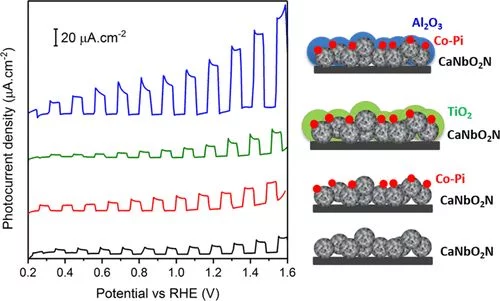Abstract:
Photoelectrochemical (PEC) solar water splitting is a promising approach to convert solar energy into sustainable hydrogen fuel using semiconductor electrodes. Owing to their visible light absorption properties, oxynitrides have shown to be attractive photocatalysts for this application. In this study, the influence of the preparation method of CaNbO2N particles on their morphological and optical properties, and thereby their PEC performance, is investigated. The best performing CaNbO2N photoanode is produced by ammonolysis of Nb-enriched calcium niobium oxide. The enhanced photoactivity arises from an enlarged surface area and superior visible light absorption properties. The photoactivity of this photoanode was further enhanced by photodeposition of CoPi cocatalyst and by the atomic layer deposition of an Al2O3 overlayer. A photocurrent density of 70 μA cm–2 at 1.23 V versus reversible hydrogen electrode was achieved. The observed enhancement of the PEC performance after CoPi/Al2O3 deposition is the combined effect of the improved kinetics of oxygen evolution because of the CoPi cocatalyst and the reduced surface recombination of the photogenerated carriers at the Al2O3 surface layer.
Keywords: Pulsed laser deposition; Laser induced plasma; Double layer; Plasma plume expansion;
Facility: Thin Films and Interfaces, LMX, ENE, ETHZ, Center for Nanointegration Duisburg-Essen - University of Duisburg-Essen, Department of Chemistry - University of Zurich
Reference: F. Haydous et al., J. Phys. Chem. C, 123 (2), pp 1059–1068 (2019), online publication 24. 12. 2018, in print 17.01.2019
Read full article: here

